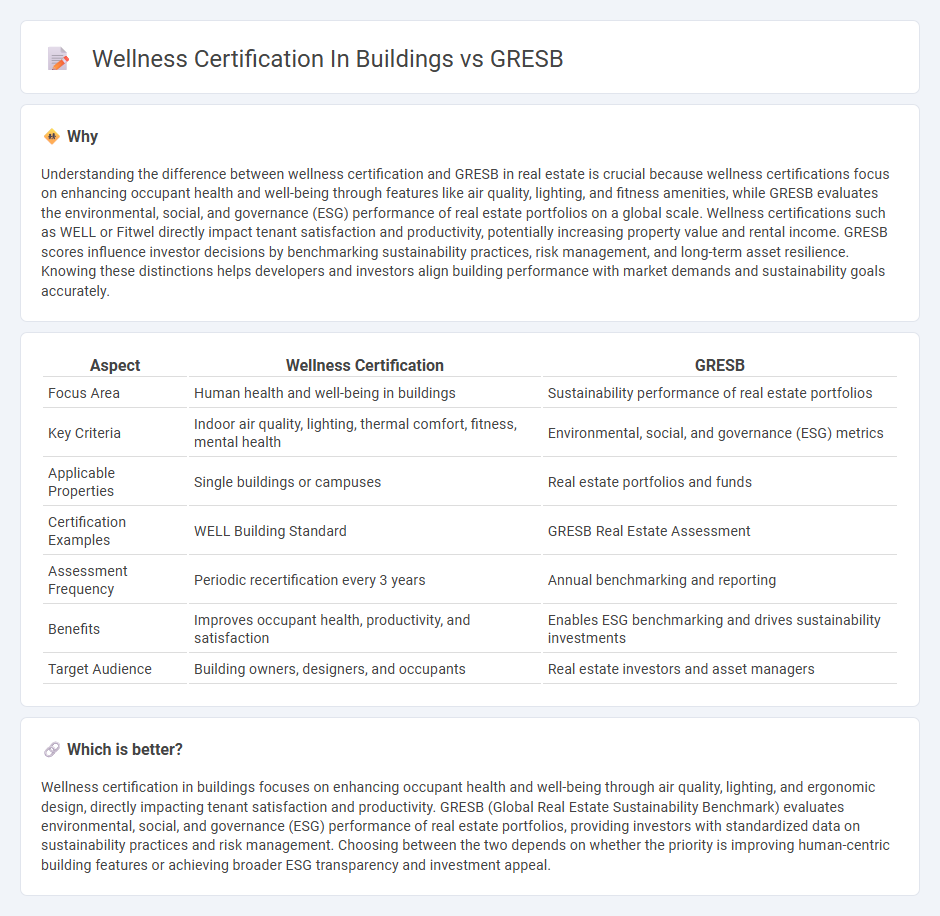
Wellness certification in buildings focuses on enhancing occupant health and well-being through design, air quality, lighting, and biophilic elements, while GRESB primarily assesses environmental, social, and governance (ESG) performance of real estate portfolios. Wellness certifications like WELL and Fitwel emphasize human-centric features that improve productivity and comfort, whereas GRESB provides comprehensive sustainability benchmarking and risk assessment for investors. Explore how these frameworks complement each other to elevate real estate asset value and stakeholder satisfaction.
Why it is important
Understanding the difference between wellness certification and GRESB in real estate is crucial because wellness certifications focus on enhancing occupant health and well-being through features like air quality, lighting, and fitness amenities, while GRESB evaluates the environmental, social, and governance (ESG) performance of real estate portfolios on a global scale. Wellness certifications such as WELL or Fitwel directly impact tenant satisfaction and productivity, potentially increasing property value and rental income. GRESB scores influence investor decisions by benchmarking sustainability practices, risk management, and long-term asset resilience. Knowing these distinctions helps developers and investors align building performance with market demands and sustainability goals accurately.
Comparison Table
| Aspect | Wellness Certification | GRESB |
|---|---|---|
| Focus Area | Human health and well-being in buildings | Sustainability performance of real estate portfolios |
| Key Criteria | Indoor air quality, lighting, thermal comfort, fitness, mental health | Environmental, social, and governance (ESG) metrics |
| Applicable Properties | Single buildings or campuses | Real estate portfolios and funds |
| Certification Examples | WELL Building Standard | GRESB Real Estate Assessment |
| Assessment Frequency | Periodic recertification every 3 years | Annual benchmarking and reporting |
| Benefits | Improves occupant health, productivity, and satisfaction | Enables ESG benchmarking and drives sustainability investments |
| Target Audience | Building owners, designers, and occupants | Real estate investors and asset managers |
Which is better?
Wellness certification in buildings focuses on enhancing occupant health and well-being through air quality, lighting, and ergonomic design, directly impacting tenant satisfaction and productivity. GRESB (Global Real Estate Sustainability Benchmark) evaluates environmental, social, and governance (ESG) performance of real estate portfolios, providing investors with standardized data on sustainability practices and risk management. Choosing between the two depends on whether the priority is improving human-centric building features or achieving broader ESG transparency and investment appeal.
Connection
Wellness certification in buildings, such as WELL or Fitwel, prioritizes occupant health and well-being through design, air quality, and lighting standards, which aligns with GRESB's focus on sustainable and resilient real estate investments. GRESB evaluates environmental, social, and governance (ESG) performance, incorporating wellness certifications as key indicators of social sustainability and tenant satisfaction. Integrating wellness certifications enhances a property's GRESB score by demonstrating commitment to health-centric environments that attract investors and occupants seeking sustainable real estate.
Key Terms
Sustainability Benchmarking
GRESB provides a rigorous sustainability benchmarking framework focusing on environmental, social, and governance (ESG) performance for real estate portfolios worldwide. Wellness certifications, such as WELL, emphasize occupant health and well-being through design and operational standards without directly benchmarking broader sustainability metrics. Explore the distinctions and synergies between GRESB and wellness certifications to enhance your building's sustainability strategy.
Health & Wellbeing Standards
GRESB evaluates sustainability performance in real estate, emphasizing environmental, social, and governance (ESG) factors, while wellness certifications like WELL and Fitwel specifically target health and wellbeing standards in buildings. WELL Certification assesses air, water, light, fitness, comfort, and mental health, whereas GRESB incorporates broader ESG criteria including tenant engagement and community impact. Explore detailed comparisons to understand how each framework drives healthier building environments.
ESG (Environmental, Social, Governance)
GRESB assesses ESG performance of real estate assets through comprehensive data on energy efficiency, carbon emissions, and social impact, providing investors with benchmarks for sustainable portfolio management. Wellness certifications, such as WELL and Fitwel, emphasize occupant health and well-being by evaluating air quality, lighting, and access to green spaces within buildings. To explore how these frameworks drive ESG integration and improve building performance, learn more about their strategic roles in sustainable development.
Source and External Links
GRESB - Wikipedia - GRESB is a Netherlands-based company that conducts annual sustainability assessments of real estate and infrastructure investments, providing standardized ESG data and benchmarks used by fund managers and investors internationally.
What is GRESB? - IBM - GRESB produces recognized benchmarks tracking ESG performance for commercial real estate and infrastructure, helping investors and managers measure and improve sustainability practices.
What is GRESB? Everything you need to know. - Comundo - GRESB is a Dutch organization providing ESG data and benchmarks for real assets, enabling investors and asset managers worldwide to assess and enhance sustainability in real estate and infrastructure.
 dowidth.com
dowidth.com